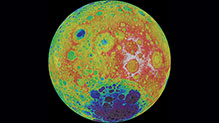


 All About the Moon (K-4)
NASA Interactive Moon
Lunar Reconnaissance
Artemis Mission Page
What is Artemis?
What is Artemis? (K-4)
Artemis Program (5-8)
Orion Spacecraft
Space Launch System
Next Gen Space Suits
Artemis Spacesuits Podcast
Mobile Launcher
Gateway
Preparing To Go
Human Landing System
Moon Landing Sites
Moon History: Apollo Missions
One Giant Leap
Apollo 50th Anniversary
Apollo 11 Bootprint
Artemis Videos
All About the Moon (K-4)
NASA Interactive Moon
Lunar Reconnaissance
Artemis Mission Page
What is Artemis?
What is Artemis? (K-4)
Artemis Program (5-8)
Orion Spacecraft
Space Launch System
Next Gen Space Suits
Artemis Spacesuits Podcast
Mobile Launcher
Gateway
Preparing To Go
Human Landing System
Moon Landing Sites
Moon History: Apollo Missions
One Giant Leap
Apollo 50th Anniversary
Apollo 11 Bootprint
Artemis Videos
Let's take a look at the history of going to the moon. NASA's Apollo program succeeded in landing the first astronauts on the Moon on July 20, 1969. Astronauts Neil Armstrong and Buzz Aldrin first walked on the lunar surface during the Apollo 11 mission, while Michael Collins remained in lunar orbit with the command and service module. All three astronauts landed safely on Earth on July 24, 1969. During the course of the Apollo program, which spanned from 1961 to 1972, six NASA spaceflights landed on the Moon and a total of twelve men walked on the Moon.
Apollo proved it is possible to land humans on the Moon and return them safely to Earth. Artemis will take this a step further and use the Moon as a testbed for human exploration of Mars. Apollo astronauts visited the Moon for a few days or less. Artemis astronauts will visit the Moon for multi-month stays with time split between the Gateway and the lunar surface. Apollo astronauts explored the Moon’s equatorial region. Artemis astronauts will visit the lunar South Pole. These are just some of the differences between the two programs. What are other differences? How might your quote speak to how far we have come and what the future holds?
The moon is our nearest and most accessible neighbor, however, it's still an average of 238,855 miles (384,400 km) away. How far away is that? That is 30 Earths away! To get to the moon, Astronauts will launch in the Orion Spacecraft atop the powerful Space Launch System Rocket. Orion, powered by a service module provided by the European Space Agency that has been specifically designed for deep space human operations for up to four crew members. Learn more about how astronauts will live and work onboard the Orion Spacecraft on the way to the Gateway, the new lunar outpost. From the Gateway, astronauts will use lunar landers to and from the moon's surface. We will build an Artemis Base Camp with a living area and rovers in order for astronauts to live, learn, and work on the Moon for extended stays. These are the essentials to return astronauts to the Moon to stay!
The Artemis mission will land the first woman and the next man on the Moon by 2024. How might your quote commemorate this historic milestone for women?
Artemis will reveal new knowledge about the Moon, Earth, and our origins in the solar system. NASA will use precision landing technologies and develop new mobility capabilities to allow robots and astronauts to travel greater distances and explore new regions of the lunar surface. Maybe your quote will be inspired by the robots and astronauts that will explore more and conduct more science on the Moon than ever before.
From upgraded launch facilities at Kennedy Space Center to new modern next-generation spacesuits, Artemis has it all. Take a look at what is needed to get ready for launch. Check out NASA’s xEMU and Orion crew survival system suits. How will these new suits give astronauts the protection they need for their journey?
The "Next Moon Step" Challenge is presented in support of NASA's Artemis program. The student challenge is part of NASA's efforts to engage the public in its missions to the Moon and Mars. NASA is returning to the Moon for scientific discovery, economic benefits, and inspiration for a new generation. Working with its partners throughout the Artemis program, the agency will fine-tune precision landing technologies and develop new mobility capabilities that allow robots and crew to travel greater distances and explore new regions of the Moon. On the surface, the agency has proposed building a new habitat and rovers, testing new power systems and much more to get ready for human exploration of Mars. Charged with returning to the Moon in the next four years, NASA’s Artemis program will reveal new knowledge about the Moon, Earth, and our origins in the solar system.
Thank you for your interest in contacting Future Engineers. We look forward to connecting with you!
General Inquiries
support@futureengineers.orgSponsorship Inquiries
sponsor@futureengineers.org